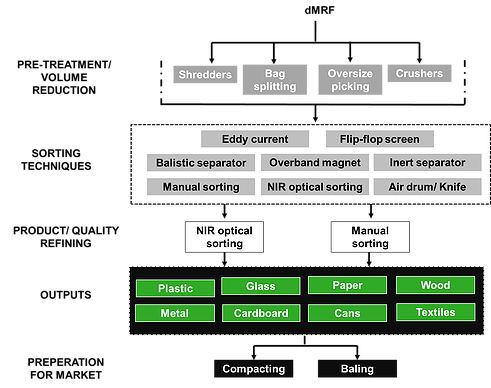A dirty material recycling facility (dMRF) involves segregating valuable materials from a mixed ‘dirty’ waste stream rather than separating the components of a segregated ‘clean’ waste stream.
A dMRF may accept mixed solid waste, mixed commercial waste or construction and demolition waste. Target materials for a dMRF will usually include aluminium and steel, and may also include mixed plastics, mixed paper / card, wood, textiles and aggregate / glass. The remaining materials may be used to produce a refuse derived fuel (RDF) for energy recovery facilities.

Configuration
Technology restrictions
- Not suitable for hazardous materials
- Will only recover a small amount (
Main license requirements for dMRF
Advantages:
- Relatively simple technology and systems to extract recyclables from mixed waste
- Possibly provide residual material for fuel production
- Technology may be applied to a wide range of waste streams
- Provide significant employment through hand sorting and operation of the plant
Disadvantages:
- Possible injury risk from handling and machinery
- Few employment opportunities (compared to cMRF)
- Quality of recycling materials is compromised as sorting needs to be done effectively and efficiently in dMRF facility
- High use of water
Robinson Deep MRF, Turffontein, Johannesburg, Gauteng
Pikitup Johannesburg SOC Limited initiated a pilot ‘Separation at Source’ project in the Waterval Depot Area in November 2009, targeting 35,000 households. The vision of the 'Separation at Source' team is to ‘divert recyclable waste away from landfill’ through a separate dry recycling (i.e. glass, plastic and cans). The recyclables are collected by co-operatives and taken to MRFs and recycling facilities.
In support of the roll-out of the 'Separation at Source' programme, the Robinson Deep material recycling facility has been re-commissioned as a clean MRF. The ‘Separation at Source’ pilot programme was expanded to other areas (Zondi, Diepsloot and Orange Farm), and currently serves approximately 265,000 households, collecting 4,970 tonnes per annum of recyclable materials. Pikitup intends extending this service to cover the entire City by June 2014, i.e. all 958,000 households.
The Robinson Deep MRF was built in the early ‘90s and was previously operated as a ‘dirty’ MRF, receiving mixed waste and sorting through the ‘dirty’ mixed waste to recover recyclables. Recovery was inefficient and the demand for the recovered ‘contaminated’ materials was poor. This operation was found not to be viable and subsequently the facility was closed, prior to re-commissioning as a clean MRF.
The MRF is partly mechanical and partly manually operated, recovering recyclables from the general, mixed municipal waste stream. Mechanised conveyors and manual sorters are utilised. Reclaimers, previously hand picking recyclables from landfill sites, will be provided formal employment in the facility and removed from hazardous tipping areas. About 450 jobs are expected to be created at the Robinson Deep MRF when in full operation. The reclaimers can be deployed to the MRF to work under better controlled and hygienic conditions. It is envisaged that as the City-wide roll-out progresses, less and less recyclables will find its way to the landfill. This will also contribute significantly to the reduction of waste that is disposed at the landfill site, and thereby prolonging its lifespan.
